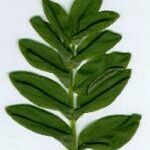| Common Name: |
Ananas |
| Other Names: |
Golden Rocket, Pineapple |
| Botanical Name: |
Ananas comosus |
| Genus: |
Ananus |
| Family: |
Bromeliaceae |
| Native Location: |
Brazil |
| Cultivation: |
Well-drained, rich, sandy soil, in sun and high humidity. |
| Propagation: |
By basal offsets in early summer; by cutting off the leafy top of a fruit and allowing it to dry off for a day or two before inserting in a mixture of damp peat and either sand or perlite, at 21°C (70°F) |
| Harvest: |
Fruits are cut when unripe or ripe, and used fresh or pressed for juice. Bromelain is extracted commercially from stems and foliage for food supplements, tablets, and capsules. |
| Height: |
1m (3ft) |
| Width: |
1m (3ft) |
| Variations: |
Variegatus
Has cream-striped, often red-flushed fruits. |
| Hardiness: |
Min. 15°C (59°F) |
| Parts Used: |
Fruits, stems, leaves |
| Properties: |
An acidic, cooling, soothing herb that improved digestion, has diuretic, laxative, and antihelmintic effects, and acts as a uterine tonic. |
| Medicinal Uses: |
Internally, especially in Ayurvedic medicine, for dyspepsia, flatulence, poor digestion, excessive stomach acid (juice of ripe or unripe fruits), constipation, and intestinal parasites (juice of foliage). Juice of unripe fruits and foliage is not given to pregnant women because it stimulates the uterus and may cause miscarriage. Bromelain aids digestion (especially of protiens) and controls E. Coli and other digestive infections.
To treat digestive properties, inflammation, asthma, obesity, constipation, and wounds. |
| Possible Side Effects: |
Pineapple's side effects include diarrhea and allergic reactions. |
| Drug Interactions: |
| Taking pineapple with these drugs may increase the risk of bleeding and bruising: |
| Alteplase, (Activase, Cathflo Activase) |
Aminosalicylic Acid, (Nemasol Sodium, Paser) |
Antithrombin III, (Thrombate III) |
| Argatroban, (Argatroban) |
Aspirin, (Bufferin, Ecotrin) |
Bivalirudin, (Angiomax) |
| Choline Magnesium trisalicylate, (Trilisate) |
Choline Salicylate, (Teejel) |
Dalteparin, (Fragmin) |
| Danaparoid, (Orgaran) |
Enoxaparin, (Lovenox) |
Fondaparinux, (Arixtra) |
| Heparin, (Hepalean, Hep-Lock) |
Lepirudin, (Refludan) |
Retaplase, (Retavase) |
| Salsalate, (Amgesic, Salflex) |
Streptokinase, (Streptase) |
Tenecteplase, (TNKase) |
| Tinzaparin, (Innohep) |
Urokinase, (Abbokinase) |
Warfarin, (Coumadin, Jantoven) |
| Taking pineapple with these drugs may interfere with the action of the drug: |
| Benazepril, (Lotensin) |
Captopril, (Capoten, Novo-Captopril) |
Cilazapril, (Inhibace) |
Delapril, (Adecut, Delakete) |
| Enalapril, (Vasotec) |
Fosinopril, (Monopril) |
Imidapril, (Novarok, Tanatril) |
Lisinopril, (Prinivil, Zestril) |
| Moexipril, (Univasc) |
Perindopril Erbumine, (Aceon, Coversyl) |
Quinapril, (Accupril) |
Ramipril, (Altace) |
| Spirapril, (Spirapril) |
Trandolapril, (Mavik) |
|
| Culinary Uses: |
Fruits are eaten raw, cooked, candied, or juiced. Young shoots and flower spikes are eaten as a vegetable in producer countries. |
| Economic Uses: |
Source of bromelain, used in digestive supplements; also for tenderizing meat; clarifying fruit juice, and in the baking and brewing industries. |
| Bibliography: |
Encylopedia of Herbs by Deni Brown Copyright ©: 1995, 2001 Dorling Kindersley Limited pg 120
The Essential Herb-Drug-Vitamin Interaction Guide by Geo. T. Grossberg,MD and Barry Fox,PhD Copyright©2007 Barry Fox,PhD. Pp.368-369 |
